Comparing Erikson and Bowlby: A Developmental Psychology Report
VerifiedAdded on 2022/11/22
|9
|1343
|424
Report
AI Summary
This report provides an in-depth analysis of developmental psychology, focusing on Erik Erikson's psychosocial theory and John Bowlby's attachment theory. The report begins with a brief introduction to developmental psychology, defining its scope and goals. It then delves into a literature review, exploring Erikson's stages of psychosocial development, with a specific emphasis on the infancy stage (trust vs. mistrust). The report compares and contrasts Erikson's theory with Bowlby's attachment theory, highlighting the similarities and differences in their perspectives on early childhood experiences and their impact on personality development. The report emphasizes the importance of caregiver-child relationships and their influence on the child's future. The conclusion summarizes the key findings and underscores the significance of both theories in understanding human development. The report includes references to scholarly articles to support its arguments.
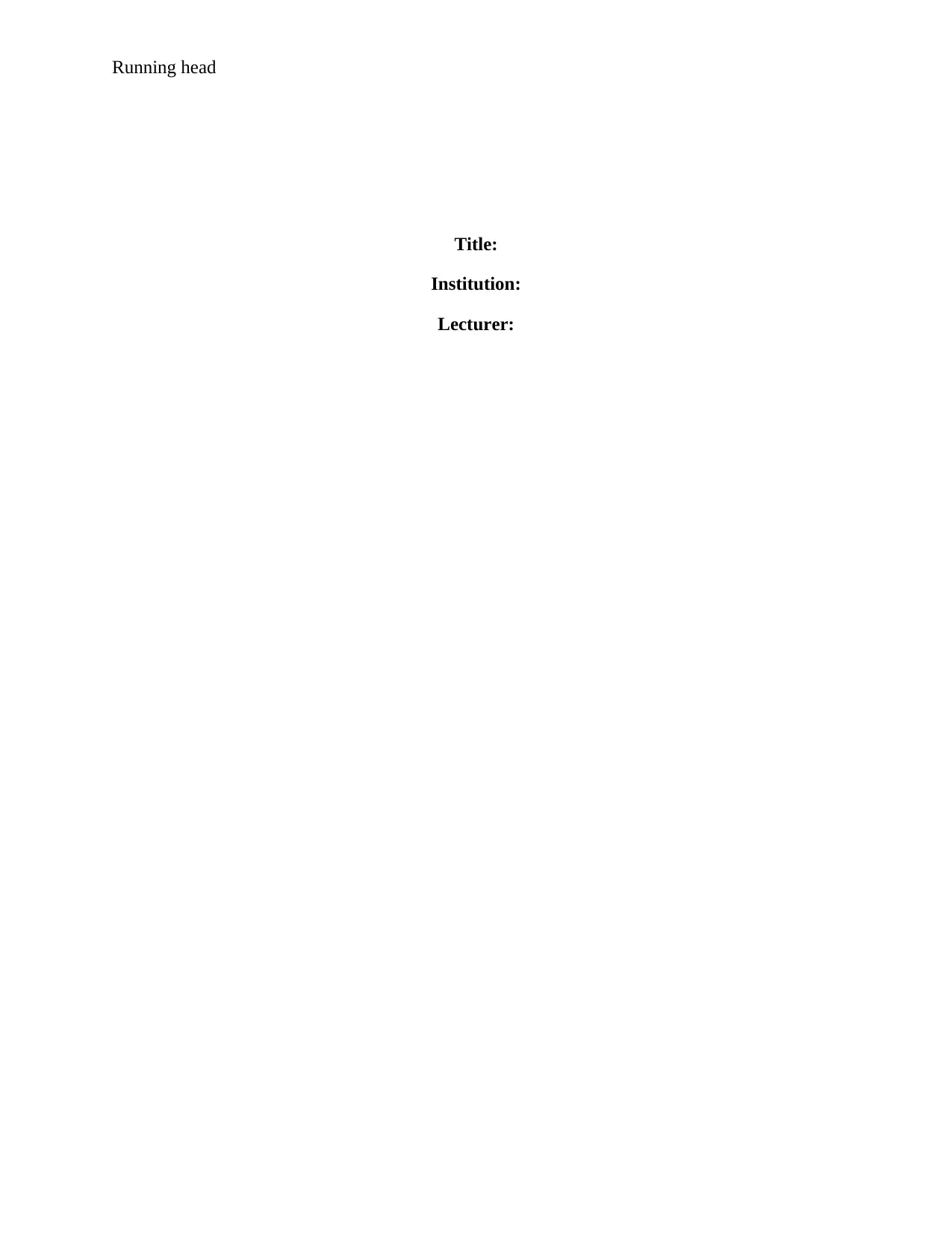
Running head
Title:
Institution:
Lecturer:
Title:
Institution:
Lecturer:
Paraphrase This Document
Need a fresh take? Get an instant paraphrase of this document with our AI Paraphraser
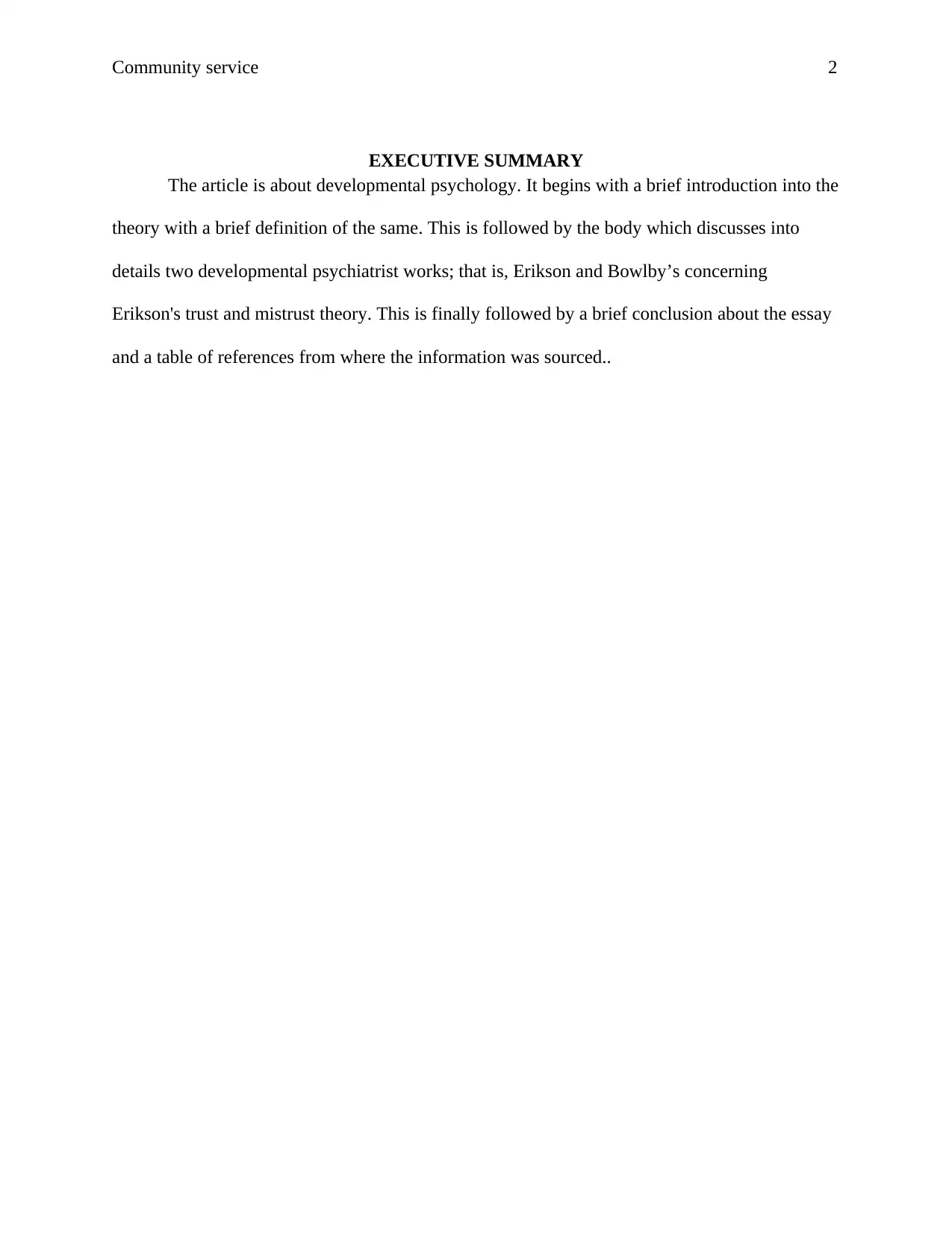
Community service 2
EXECUTIVE SUMMARY
The article is about developmental psychology. It begins with a brief introduction into the
theory with a brief definition of the same. This is followed by the body which discusses into
details two developmental psychiatrist works; that is, Erikson and Bowlby’s concerning
Erikson's trust and mistrust theory. This is finally followed by a brief conclusion about the essay
and a table of references from where the information was sourced..
EXECUTIVE SUMMARY
The article is about developmental psychology. It begins with a brief introduction into the
theory with a brief definition of the same. This is followed by the body which discusses into
details two developmental psychiatrist works; that is, Erikson and Bowlby’s concerning
Erikson's trust and mistrust theory. This is finally followed by a brief conclusion about the essay
and a table of references from where the information was sourced..
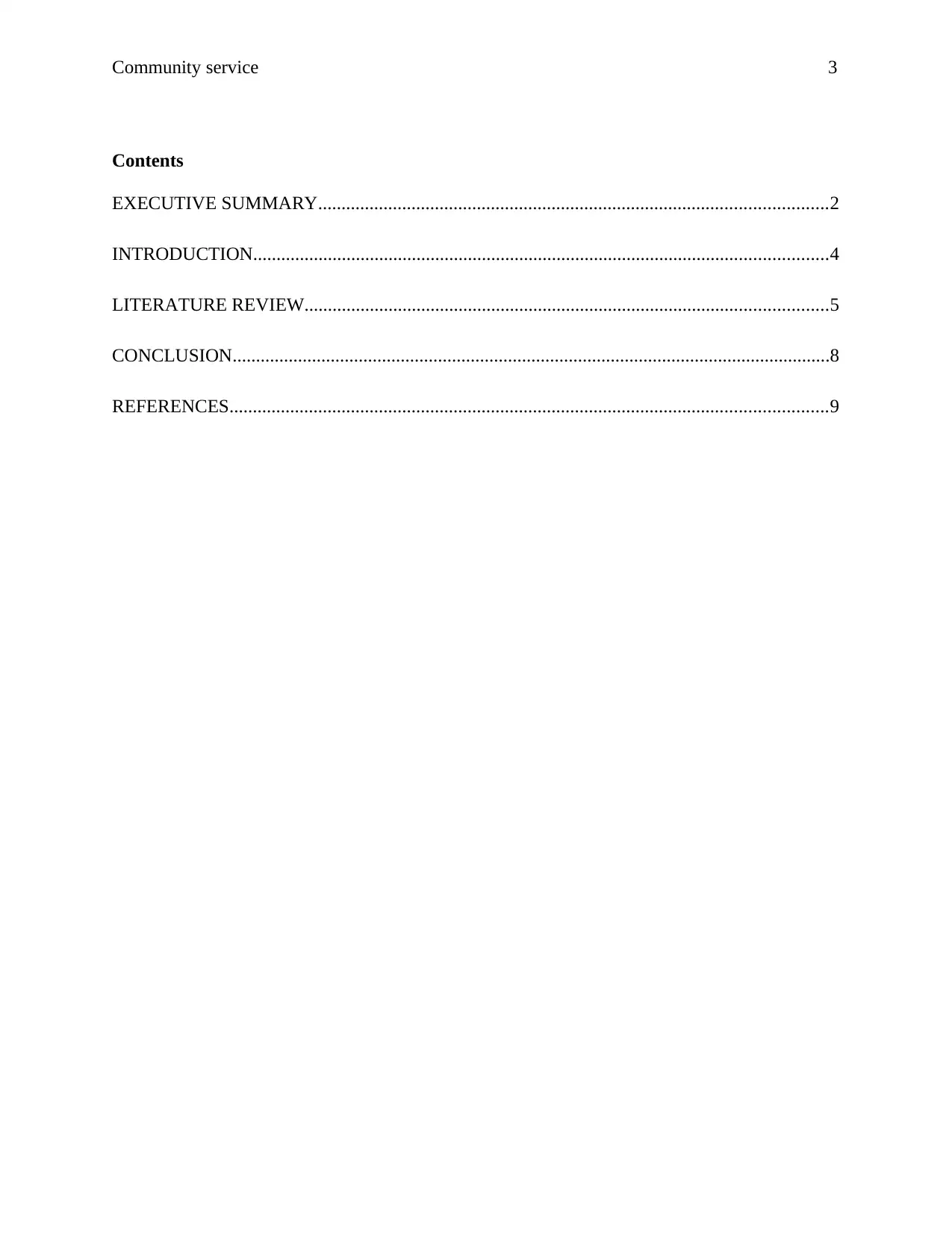
Community service 3
Contents
EXECUTIVE SUMMARY.............................................................................................................2
INTRODUCTION...........................................................................................................................4
LITERATURE REVIEW................................................................................................................5
CONCLUSION................................................................................................................................8
REFERENCES................................................................................................................................9
Contents
EXECUTIVE SUMMARY.............................................................................................................2
INTRODUCTION...........................................................................................................................4
LITERATURE REVIEW................................................................................................................5
CONCLUSION................................................................................................................................8
REFERENCES................................................................................................................................9
⊘ This is a preview!⊘
Do you want full access?
Subscribe today to unlock all pages.

Trusted by 1+ million students worldwide
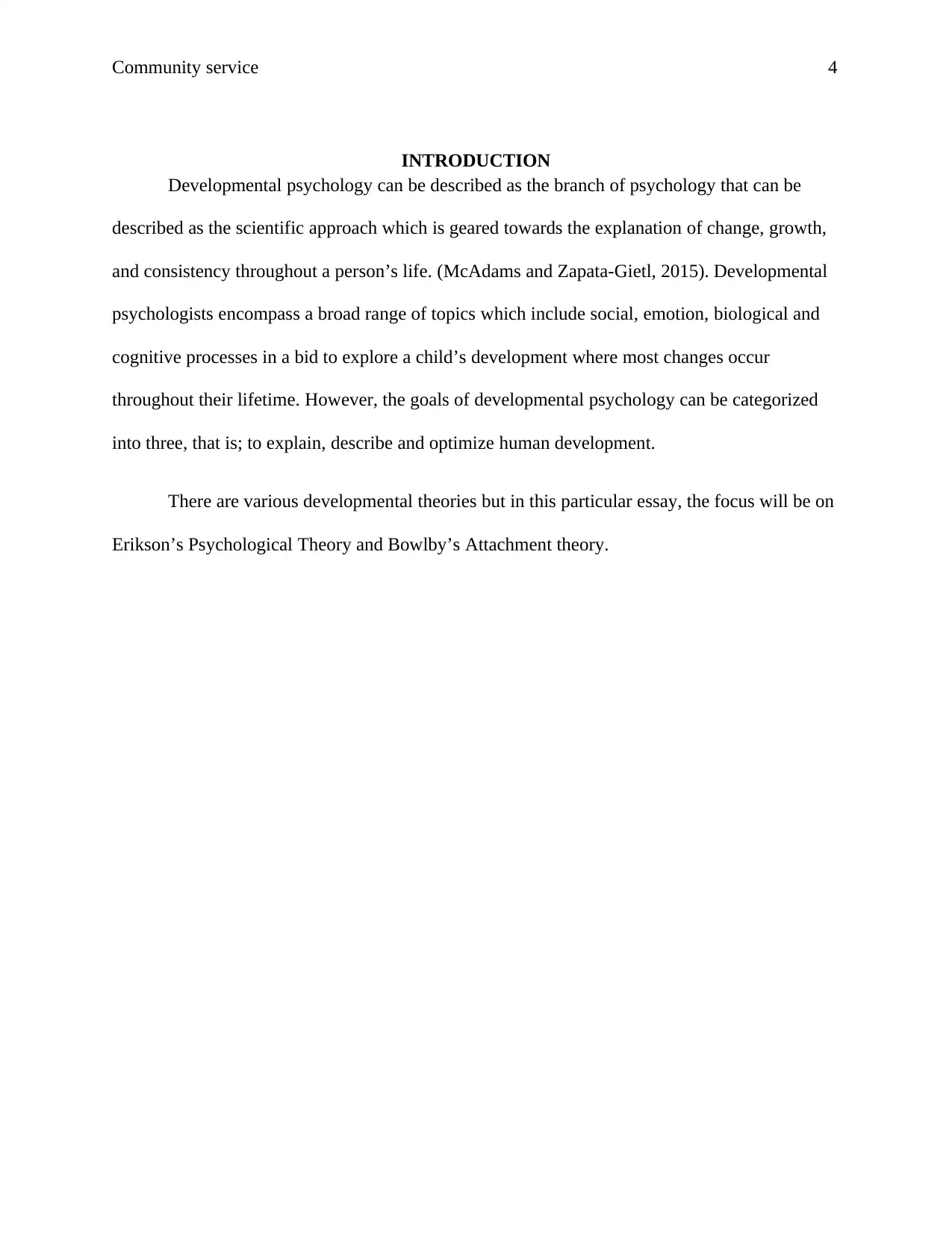
Community service 4
INTRODUCTION
Developmental psychology can be described as the branch of psychology that can be
described as the scientific approach which is geared towards the explanation of change, growth,
and consistency throughout a person’s life. (McAdams and Zapata-Gietl, 2015). Developmental
psychologists encompass a broad range of topics which include social, emotion, biological and
cognitive processes in a bid to explore a child’s development where most changes occur
throughout their lifetime. However, the goals of developmental psychology can be categorized
into three, that is; to explain, describe and optimize human development.
There are various developmental theories but in this particular essay, the focus will be on
Erikson’s Psychological Theory and Bowlby’s Attachment theory.
INTRODUCTION
Developmental psychology can be described as the branch of psychology that can be
described as the scientific approach which is geared towards the explanation of change, growth,
and consistency throughout a person’s life. (McAdams and Zapata-Gietl, 2015). Developmental
psychologists encompass a broad range of topics which include social, emotion, biological and
cognitive processes in a bid to explore a child’s development where most changes occur
throughout their lifetime. However, the goals of developmental psychology can be categorized
into three, that is; to explain, describe and optimize human development.
There are various developmental theories but in this particular essay, the focus will be on
Erikson’s Psychological Theory and Bowlby’s Attachment theory.
Paraphrase This Document
Need a fresh take? Get an instant paraphrase of this document with our AI Paraphraser
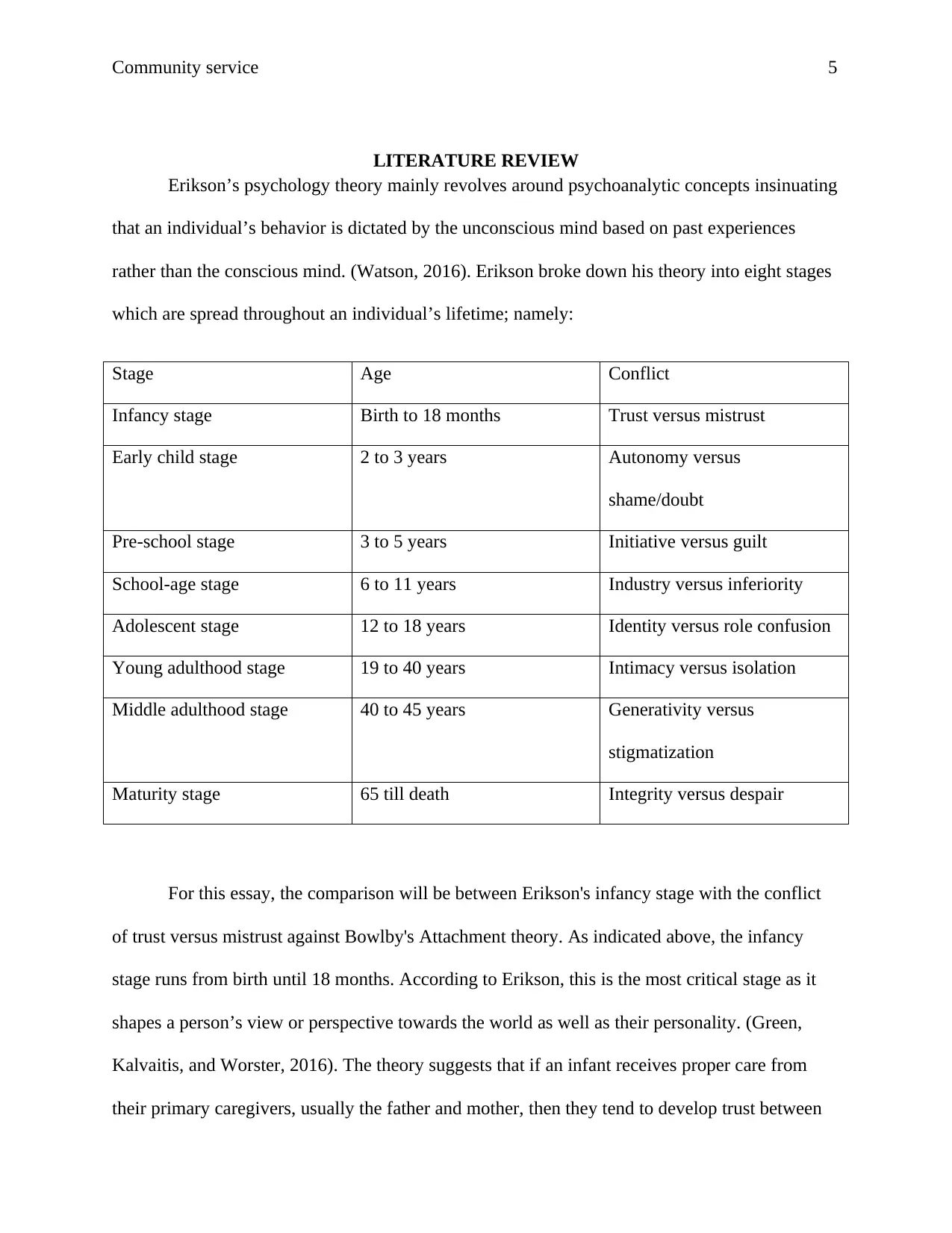
Community service 5
LITERATURE REVIEW
Erikson’s psychology theory mainly revolves around psychoanalytic concepts insinuating
that an individual’s behavior is dictated by the unconscious mind based on past experiences
rather than the conscious mind. (Watson, 2016). Erikson broke down his theory into eight stages
which are spread throughout an individual’s lifetime; namely:
Stage Age Conflict
Infancy stage Birth to 18 months Trust versus mistrust
Early child stage 2 to 3 years Autonomy versus
shame/doubt
Pre-school stage 3 to 5 years Initiative versus guilt
School-age stage 6 to 11 years Industry versus inferiority
Adolescent stage 12 to 18 years Identity versus role confusion
Young adulthood stage 19 to 40 years Intimacy versus isolation
Middle adulthood stage 40 to 45 years Generativity versus
stigmatization
Maturity stage 65 till death Integrity versus despair
For this essay, the comparison will be between Erikson's infancy stage with the conflict
of trust versus mistrust against Bowlby's Attachment theory. As indicated above, the infancy
stage runs from birth until 18 months. According to Erikson, this is the most critical stage as it
shapes a person’s view or perspective towards the world as well as their personality. (Green,
Kalvaitis, and Worster, 2016). The theory suggests that if an infant receives proper care from
their primary caregivers, usually the father and mother, then they tend to develop trust between
LITERATURE REVIEW
Erikson’s psychology theory mainly revolves around psychoanalytic concepts insinuating
that an individual’s behavior is dictated by the unconscious mind based on past experiences
rather than the conscious mind. (Watson, 2016). Erikson broke down his theory into eight stages
which are spread throughout an individual’s lifetime; namely:
Stage Age Conflict
Infancy stage Birth to 18 months Trust versus mistrust
Early child stage 2 to 3 years Autonomy versus
shame/doubt
Pre-school stage 3 to 5 years Initiative versus guilt
School-age stage 6 to 11 years Industry versus inferiority
Adolescent stage 12 to 18 years Identity versus role confusion
Young adulthood stage 19 to 40 years Intimacy versus isolation
Middle adulthood stage 40 to 45 years Generativity versus
stigmatization
Maturity stage 65 till death Integrity versus despair
For this essay, the comparison will be between Erikson's infancy stage with the conflict
of trust versus mistrust against Bowlby's Attachment theory. As indicated above, the infancy
stage runs from birth until 18 months. According to Erikson, this is the most critical stage as it
shapes a person’s view or perspective towards the world as well as their personality. (Green,
Kalvaitis, and Worster, 2016). The theory suggests that if an infant receives proper care from
their primary caregivers, usually the father and mother, then they tend to develop trust between
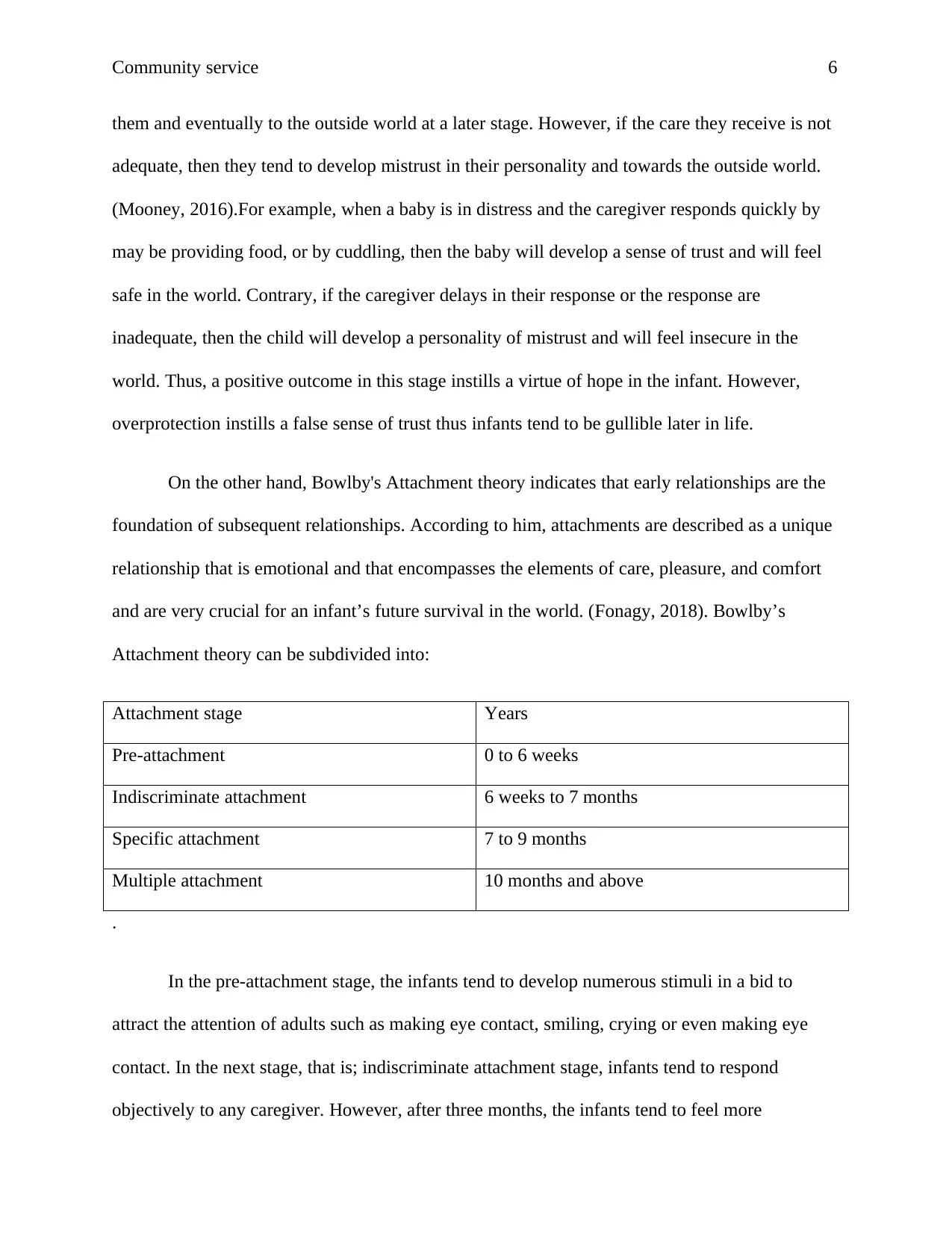
Community service 6
them and eventually to the outside world at a later stage. However, if the care they receive is not
adequate, then they tend to develop mistrust in their personality and towards the outside world.
(Mooney, 2016).For example, when a baby is in distress and the caregiver responds quickly by
may be providing food, or by cuddling, then the baby will develop a sense of trust and will feel
safe in the world. Contrary, if the caregiver delays in their response or the response are
inadequate, then the child will develop a personality of mistrust and will feel insecure in the
world. Thus, a positive outcome in this stage instills a virtue of hope in the infant. However,
overprotection instills a false sense of trust thus infants tend to be gullible later in life.
On the other hand, Bowlby's Attachment theory indicates that early relationships are the
foundation of subsequent relationships. According to him, attachments are described as a unique
relationship that is emotional and that encompasses the elements of care, pleasure, and comfort
and are very crucial for an infant’s future survival in the world. (Fonagy, 2018). Bowlby’s
Attachment theory can be subdivided into:
Attachment stage Years
Pre-attachment 0 to 6 weeks
Indiscriminate attachment 6 weeks to 7 months
Specific attachment 7 to 9 months
Multiple attachment 10 months and above
.
In the pre-attachment stage, the infants tend to develop numerous stimuli in a bid to
attract the attention of adults such as making eye contact, smiling, crying or even making eye
contact. In the next stage, that is; indiscriminate attachment stage, infants tend to respond
objectively to any caregiver. However, after three months, the infants tend to feel more
them and eventually to the outside world at a later stage. However, if the care they receive is not
adequate, then they tend to develop mistrust in their personality and towards the outside world.
(Mooney, 2016).For example, when a baby is in distress and the caregiver responds quickly by
may be providing food, or by cuddling, then the baby will develop a sense of trust and will feel
safe in the world. Contrary, if the caregiver delays in their response or the response are
inadequate, then the child will develop a personality of mistrust and will feel insecure in the
world. Thus, a positive outcome in this stage instills a virtue of hope in the infant. However,
overprotection instills a false sense of trust thus infants tend to be gullible later in life.
On the other hand, Bowlby's Attachment theory indicates that early relationships are the
foundation of subsequent relationships. According to him, attachments are described as a unique
relationship that is emotional and that encompasses the elements of care, pleasure, and comfort
and are very crucial for an infant’s future survival in the world. (Fonagy, 2018). Bowlby’s
Attachment theory can be subdivided into:
Attachment stage Years
Pre-attachment 0 to 6 weeks
Indiscriminate attachment 6 weeks to 7 months
Specific attachment 7 to 9 months
Multiple attachment 10 months and above
.
In the pre-attachment stage, the infants tend to develop numerous stimuli in a bid to
attract the attention of adults such as making eye contact, smiling, crying or even making eye
contact. In the next stage, that is; indiscriminate attachment stage, infants tend to respond
objectively to any caregiver. However, after three months, the infants tend to feel more
⊘ This is a preview!⊘
Do you want full access?
Subscribe today to unlock all pages.

Trusted by 1+ million students worldwide
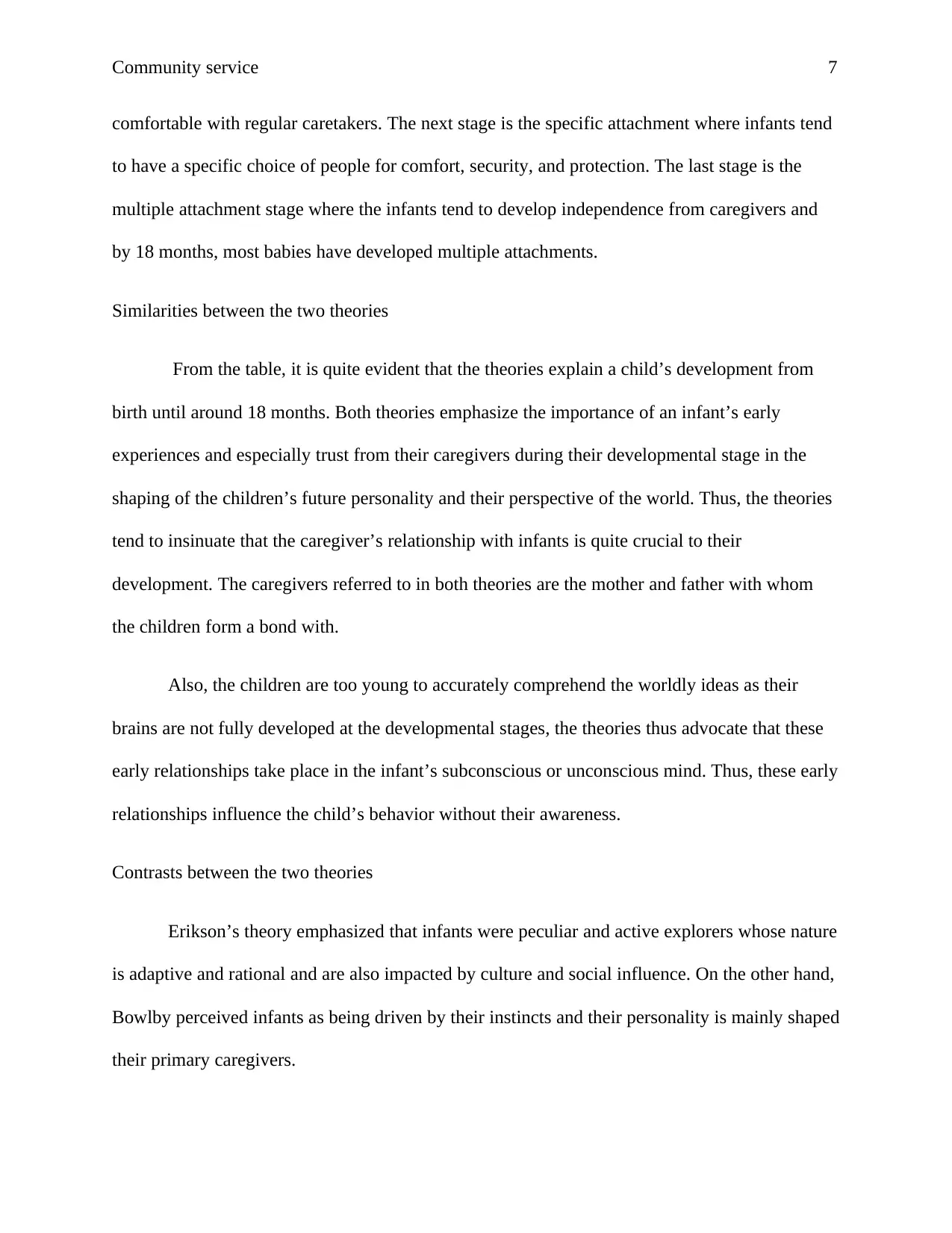
Community service 7
comfortable with regular caretakers. The next stage is the specific attachment where infants tend
to have a specific choice of people for comfort, security, and protection. The last stage is the
multiple attachment stage where the infants tend to develop independence from caregivers and
by 18 months, most babies have developed multiple attachments.
Similarities between the two theories
From the table, it is quite evident that the theories explain a child’s development from
birth until around 18 months. Both theories emphasize the importance of an infant’s early
experiences and especially trust from their caregivers during their developmental stage in the
shaping of the children’s future personality and their perspective of the world. Thus, the theories
tend to insinuate that the caregiver’s relationship with infants is quite crucial to their
development. The caregivers referred to in both theories are the mother and father with whom
the children form a bond with.
Also, the children are too young to accurately comprehend the worldly ideas as their
brains are not fully developed at the developmental stages, the theories thus advocate that these
early relationships take place in the infant’s subconscious or unconscious mind. Thus, these early
relationships influence the child’s behavior without their awareness.
Contrasts between the two theories
Erikson’s theory emphasized that infants were peculiar and active explorers whose nature
is adaptive and rational and are also impacted by culture and social influence. On the other hand,
Bowlby perceived infants as being driven by their instincts and their personality is mainly shaped
their primary caregivers.
comfortable with regular caretakers. The next stage is the specific attachment where infants tend
to have a specific choice of people for comfort, security, and protection. The last stage is the
multiple attachment stage where the infants tend to develop independence from caregivers and
by 18 months, most babies have developed multiple attachments.
Similarities between the two theories
From the table, it is quite evident that the theories explain a child’s development from
birth until around 18 months. Both theories emphasize the importance of an infant’s early
experiences and especially trust from their caregivers during their developmental stage in the
shaping of the children’s future personality and their perspective of the world. Thus, the theories
tend to insinuate that the caregiver’s relationship with infants is quite crucial to their
development. The caregivers referred to in both theories are the mother and father with whom
the children form a bond with.
Also, the children are too young to accurately comprehend the worldly ideas as their
brains are not fully developed at the developmental stages, the theories thus advocate that these
early relationships take place in the infant’s subconscious or unconscious mind. Thus, these early
relationships influence the child’s behavior without their awareness.
Contrasts between the two theories
Erikson’s theory emphasized that infants were peculiar and active explorers whose nature
is adaptive and rational and are also impacted by culture and social influence. On the other hand,
Bowlby perceived infants as being driven by their instincts and their personality is mainly shaped
their primary caregivers.
Paraphrase This Document
Need a fresh take? Get an instant paraphrase of this document with our AI Paraphraser
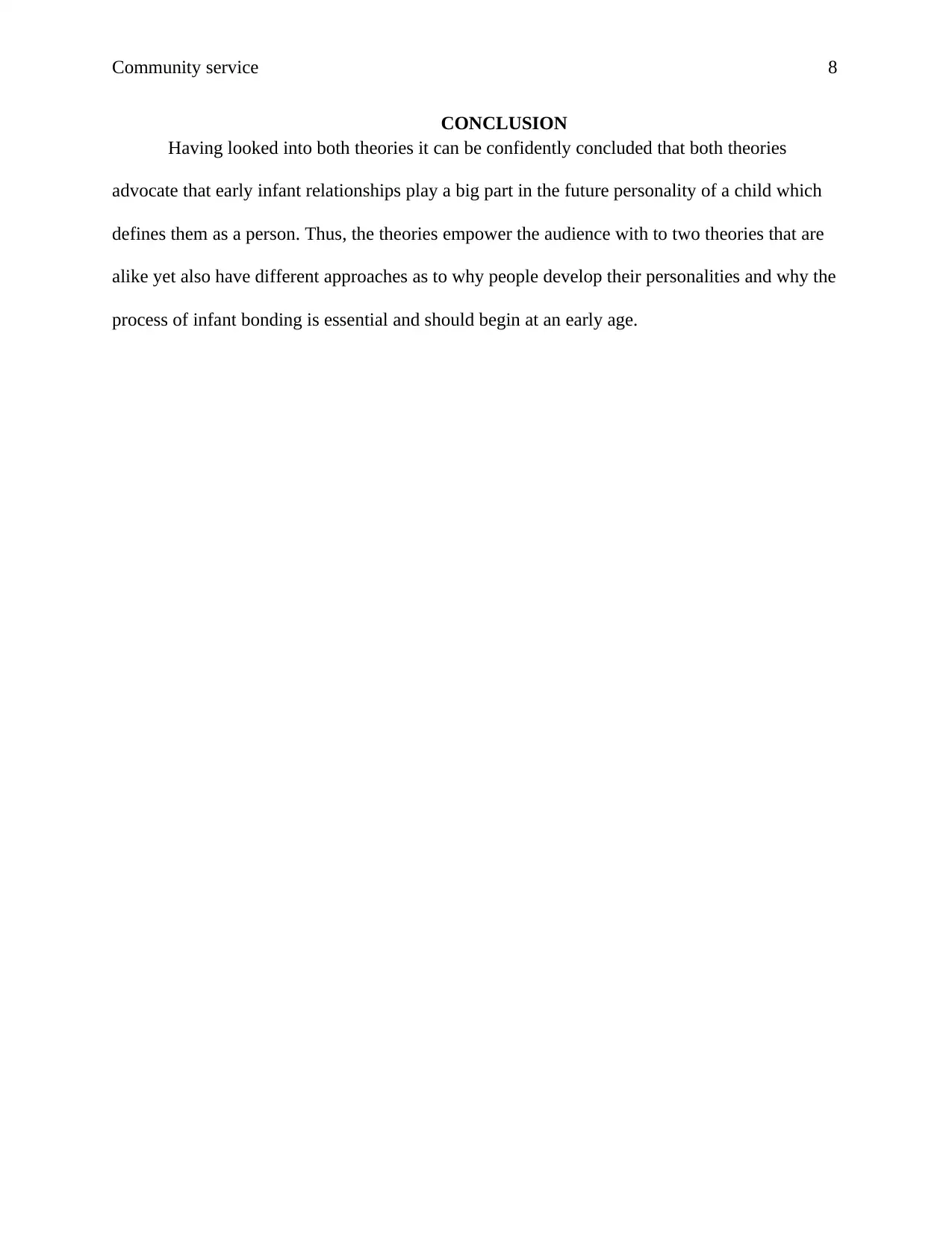
Community service 8
CONCLUSION
Having looked into both theories it can be confidently concluded that both theories
advocate that early infant relationships play a big part in the future personality of a child which
defines them as a person. Thus, the theories empower the audience with to two theories that are
alike yet also have different approaches as to why people develop their personalities and why the
process of infant bonding is essential and should begin at an early age.
CONCLUSION
Having looked into both theories it can be confidently concluded that both theories
advocate that early infant relationships play a big part in the future personality of a child which
defines them as a person. Thus, the theories empower the audience with to two theories that are
alike yet also have different approaches as to why people develop their personalities and why the
process of infant bonding is essential and should begin at an early age.
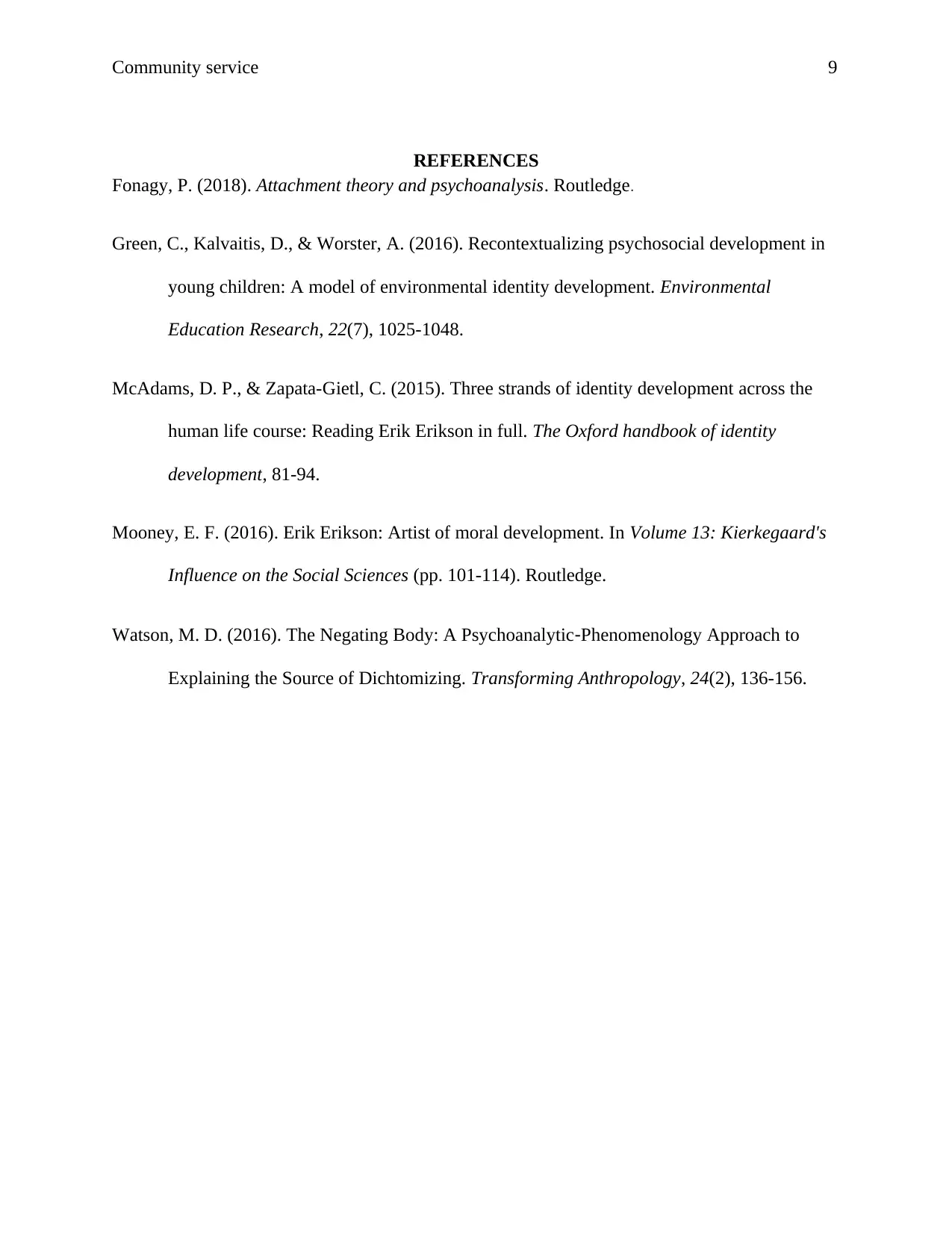
Community service 9
REFERENCES
Fonagy, P. (2018). Attachment theory and psychoanalysis. Routledge.
Green, C., Kalvaitis, D., & Worster, A. (2016). Recontextualizing psychosocial development in
young children: A model of environmental identity development. Environmental
Education Research, 22(7), 1025-1048.
McAdams, D. P., & Zapata-Gietl, C. (2015). Three strands of identity development across the
human life course: Reading Erik Erikson in full. The Oxford handbook of identity
development, 81-94.
Mooney, E. F. (2016). Erik Erikson: Artist of moral development. In Volume 13: Kierkegaard's
Influence on the Social Sciences (pp. 101-114). Routledge.
Watson, M. D. (2016). The Negating Body: A Psychoanalytic‐Phenomenology Approach to
Explaining the Source of Dichtomizing. Transforming Anthropology, 24(2), 136-156.
REFERENCES
Fonagy, P. (2018). Attachment theory and psychoanalysis. Routledge.
Green, C., Kalvaitis, D., & Worster, A. (2016). Recontextualizing psychosocial development in
young children: A model of environmental identity development. Environmental
Education Research, 22(7), 1025-1048.
McAdams, D. P., & Zapata-Gietl, C. (2015). Three strands of identity development across the
human life course: Reading Erik Erikson in full. The Oxford handbook of identity
development, 81-94.
Mooney, E. F. (2016). Erik Erikson: Artist of moral development. In Volume 13: Kierkegaard's
Influence on the Social Sciences (pp. 101-114). Routledge.
Watson, M. D. (2016). The Negating Body: A Psychoanalytic‐Phenomenology Approach to
Explaining the Source of Dichtomizing. Transforming Anthropology, 24(2), 136-156.
⊘ This is a preview!⊘
Do you want full access?
Subscribe today to unlock all pages.

Trusted by 1+ million students worldwide
1 out of 9
Related Documents
Your All-in-One AI-Powered Toolkit for Academic Success.
+13062052269
info@desklib.com
Available 24*7 on WhatsApp / Email
![[object Object]](/_next/static/media/star-bottom.7253800d.svg)
Unlock your academic potential
Copyright © 2020–2025 A2Z Services. All Rights Reserved. Developed and managed by ZUCOL.





